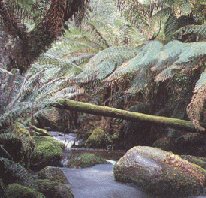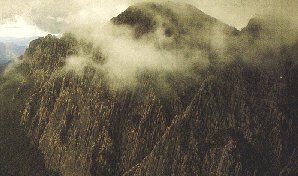|
|
|

Tasmania, rich with mountains, valleys, fertile plains, bushlands, lakes and historical villages is known as the 'Apple Isle".
History
Tasmania was discovered in 1642 by Cap. Abel Tasman of the Dutch East India Co., though
the first settlement was not established until 1803. Originally it was known as Van
Diemens Land, it was administered by the colony of NSW. Gov. King
organised a settlement at Risdon, now a suburb of Hobart, this was done mainly to retain
British domination in the face of French exploration. Still in this historical little Isle.
there are many reminders of Tasmania's earlier days as a penal colony.

Sites & Places
It has many natural attributes, attracting bushwalkers, hunters, cavers & canoers.
Larger areas of the island are uninhabited, or unexplored. Almost 40% of the state
consists of national parks and the state's SW regions have been proclaimed 'protected' by
the World Heritage Council.
Economy
Economy consists mainly of dairying, wool and beef, these being the major income earners,
while orchards, which promoted the state to the 'Apple Isle', have gone into decline.
Heavy rainfall, mountainous terrain and highland climates have restricted to farming to
small areas of river valleys, coastal plains and the lower plateaus. Fishing and Forestry
are also more important to the economy than they are in the mainland states.
Fishing is an extremely important industry to Tasmania. Both, abalone and scallop industries had their beginning in 1963 but have suffered downturns in catchings since. Tasmania was the once main producer of scallops and combined with Victoria, ranked in the top four producers in the world! Today's catch are mostly snap frozen and exported to US or France.
Other
Tasmania is rich in mineral reserves, some of which include copper, zinc, lead, silver,
gold and coal. The first discoveries came in 1884, by Bill and Mick McDonough, when they
staked a gold claim at Mount Lyell (W coat of Tas). This later proved to contain the
largest single deposit of copper ore then known in Australia. Two years later a coal
discovery at St Marys which boosted the State's failing coal industry. Most of the rich
reserves above were discovered on Mount Black in 1893.



Columba Falls, near Pyengana
Precipitous Bluff looks south over the stormy Southern Ocean where Antarctica once lay.
Kubla Khan Cave, Jade Pool. Its extensive system of crystal studded chambers began to form more than two million years ago within a massive outcrop of 450 Million year old limestone. (Snow formations occur, due to the seepage of melt water from the ice-age snowfields.)
| Hobart | Tas Interesting Places |